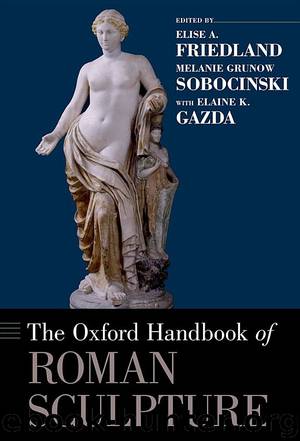The Oxford Handbook of Roman Sculpture by Elise A. Friedland Melanie Grunow Sobocinski & Elaine K. Gazda

Author:Elise A. Friedland, Melanie Grunow Sobocinski & Elaine K. Gazda
Language: eng
Format: epub
Publisher: Oxford University Press
Published: 2015-04-06T04:00:00+00:00
OBJECTS OF DEDICATION
All dedications, including sculpted ones, were inextricably linked to ritual actions, including their dedication. Peter Stewart (2010) has argued that the adoption and contours of “sculpture habits” in various parts of the empire can broadly be linked to specific communities of users, market forces, geography, and geology; ritual practices must emphatically be added to this list. Sculptured dedications were the outcome of certain rituals, including vows to the gods, and were always in dialogue with these practices.
In Gaul, Germany, and Britain, patterns of stone sculpture dedication broadly follow patterns of civic/honorific and tomb sculpture erection (McGowen 2010; see essay 5.1, Cassibry), though there are also clear distinctions: the Cotswold region (Britain), for example, lacks much civic statuary, but sanctuary sculpture is abundant. No “sculpture habit” spread across all realms; such general practices as sculpture carving may play a role—it is easier to procure carved monuments for a sanctuary when there is a sculpture workshop nearby—but they are not the only impetus for dedicating sculpture in temples.
Similarly, in North Africa, the sculpture-dedicating habit spread as part of a particular rite (McCarty 2010b), even if the numbers of dedications can be linked to the adoption of more general stoneworking practices (see essay 5.3, Baratte and Chaisemartin). The majority of thousands of votive stelae dedicated to Saturn over the imperial period come from generally wealthy communities who produced a range of carved-stone monuments; for example, the military and veteran communities of Thamagudi and Lambaesis (Algeria), the source of over half of the votive stelae in the province of Numidia, also erected nearly 20 percent of inscriptions in the entire province. Yet a number of other communities who did not adopt broad inscriptional and sculpture habits also erected the votive stelae, suggesting that the pattern of general stone-monument use does not map neatly onto religious dedications. Instead, the African stelae are tied to a particular ritual: they were commissioned and dedicated in conjunction with a holocaust sacrifice, usually of either infants or ovicaprines, whose remains were placed in an urn and buried. By their placement above or immediately adjacent to the urns with sacrificial remains, the stelae were closely linked to the sacrifice, though not every sacrifice included the dedication of a stela: even if incorporated as an element of a specific chain of ritualized actions, sculpture dedication was always exceptional, rather than the norm.
Over 150 “confession stelae” of Asia Minor were set up in village temples of Lydia and Phrygia, most between the mid-second and mid-third centuries AD; many are sculpted with reliefs related to their divine recipients or other themes (e.g., figure 4.2.3; Petzl 1994). These stelae all outline a series of particular events in their inscriptions: the dedicant committed an offense against the god, the god punished him or her (sometimes many years later), the dedicant became aware of and expiated the crime, then dedicated the stela. If this general sequence of misfortune and expiation—minus stela dedication—was practiced in a similar manner prior to the first century AD, it has left no trace.
Download
This site does not store any files on its server. We only index and link to content provided by other sites. Please contact the content providers to delete copyright contents if any and email us, we'll remove relevant links or contents immediately.
| Africa | Americas |
| Arctic & Antarctica | Asia |
| Australia & Oceania | Europe |
| Middle East | Russia |
| United States | World |
| Ancient Civilizations | Military |
| Historical Study & Educational Resources |
The Daily Stoic by Holiday Ryan & Hanselman Stephen(3228)
The Fate of Rome: Climate, Disease, and the End of an Empire (The Princeton History of the Ancient World) by Kyle Harper(3003)
People of the Earth: An Introduction to World Prehistory by Dr. Brian Fagan & Nadia Durrani(2700)
Ancient Worlds by Michael Scott(2622)
Babylon's Ark by Lawrence Anthony(2619)
The Daily Stoic by Ryan Holiday & Stephen Hanselman(2454)
Foreign Devils on the Silk Road: The Search for the Lost Treasures of Central Asia by Peter Hopkirk(2431)
India's Ancient Past by R.S. Sharma(2414)
MOSES THE EGYPTIAN by Jan Assmann(2372)
The Complete Dead Sea Scrolls in English (7th Edition) (Penguin Classics) by Geza Vermes(2231)
Lost Technologies of Ancient Egypt by Christopher Dunn(2193)
The Earth Chronicles Handbook by Zecharia Sitchin(2179)
24 Hours in Ancient Rome by Philip Matyszak(2049)
Alexander the Great by Philip Freeman(2031)
Aztec by Gary Jennings(1973)
The Nine Waves of Creation by Carl Johan Calleman(1883)
Curse Tablets and Binding Spells from the Ancient World by Gager John G.;(1836)
Before Atlantis by Frank Joseph(1810)
Earthmare: The Lost Book of Wars by Cergat(1788)
